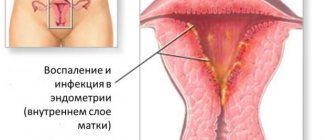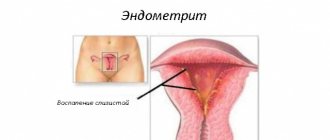What is abortion
This is an termination of pregnancy up to 22 weeks. Early (up to 12 weeks) are carried out on the initiative of the woman. They can be spontaneous (miscarriages) and performed with medication or surgery.
At a later date, the decision is made by specialists. The threat to the patient’s health and fetal malformations are taken into account.
The duration of the surgical intervention is 20 minutes. The woman remains in the medical facility until she fully recovers from anesthesia. Leaves the hospital only if there is no bleeding, vomiting, nausea, fever or pain in the lower abdomen. Menstruation appears after 25-30 days.
Indications
During pregnancy, a woman's body undergoes serious changes. A restructuring of the nervous and endocrine (hormonal) systems occurs. Abortion causes a serious blow to health. But in some cases, doctors recommend interruption.
Medical indications for termination of pregnancy:
- liver or kidney failure;
- the presence of malignant tumors;
- severe diabetes mellitus;
- pathologies of the heart and blood vessels;
- tuberculosis, rubella;
- mental disorders;
- fetal development abnormalities;
- presence of chromosomal abnormalities (Down syndrome).
Pregnancy after cesarean section, if less than 2 years have passed, is also undesirable. In the later stages or during childbirth, a scar that is not yet fully formed will create a threat of organ rupture.
Contraindications
In some cases, a doctor may refuse to allow a woman to terminate an unwanted pregnancy.
Contraindications depend on the type of procedure:
- Medication. Not indicated for intolerance to the components of the pharmaceutical drug, renal failure, bronchial asthma, taking corticosteroids, as well as in later (over 7 weeks) stages of pregnancy.
- Surgical. Contraindicated for infectious diseases of the genitourinary system, purulent inflammation, low blood coagulation (clotting).
- Vacuum. It is not performed in case of acute inflammatory processes, urogenital infections, the presence of fresh scars on the uterus, or ectopic pregnancy.
Abortion is contraindicated if the woman has a negative Rh factor, if the man has a positive one. Rhesus conflict is possible. The expectant mother's body will begin to perceive the fetus as something foreign. It will not be difficult to carry the fetus to term during the first pregnancy, but with subsequent ones the risk of miscarriage will increase.
Prevention of infertility after surgical abortion
After artificially interrupting pregnancy, the woman’s body will produce the appropriate hormones for some time. This will delay the onset of your period during the period of ovulation, but often the likelihood occurs after two weeks, depending on the menstrual cycle.
Planning for a second pregnancy can begin after just one full menstrual cycle. The most favorable time will depend on the individual characteristics of the body and the complexity of the abortion performed.
It would be a good idea to follow the general recovery recommendations:
- exclusion of heavy physical activity and heavy lifting for 2 weeks from the date of the operation;
- prevent hypothermia and protect yourself from colds;
- do not take a hot bath;
- limit sexual intercourse for two weeks, until the discharge completely stops.
In any case, when planning a pregnancy, you should initially consult a gynecologist, especially if the abortion was done for medical reasons. If a woman has already undergone several operations to terminate a pregnancy, the risk of subsequent miscarriage and stillbirth increases significantly.
Why should you contact our clinic?
Gynecologists of the highest category
Experienced specialists in gynecological operations. Experience of specialists from 15 years.
Modern equipment
Modern equipment from the world's best manufacturers.
Expert class equipment
Ultrasound is performed using expert-class equipment manufactured by General Electric, SONY, Mindray.
Tests and ultrasound on the day of treatment
Tests, x-rays, ultrasound with interpretation, dressings on the day of treatment in Moscow.
Consultations for adults and children
A network of gynecological clinics in Moscow. Clinics near the metro.
Experienced doctors
Our experienced doctors with over 15 years of experience. Candidates of Medical Sciences.
How anesthesia is done
The gynecologist chooses the type of anesthesia depending on the type of abortion and the general health of the woman.
It could be:
- General anesthesia. There is a violent inhibition of the functions of the central nervous system. Mask and intravenous are used.
- Local anesthesia. An injection with an anesthetic is given in the cervix. Painful sensations disappear. Performed as a preparation for epidural (into the spine area) anesthesia.
- Sedation. This is a superficial dream. An anesthetic is used in small doses. The patient breathes independently, is conscious, and is easily brought out of the inhibited state. There are oral, parenteral (bypassing the digestive tract) and inhalational sedation.
Anesthetics are used for pain relief.
This:
- Profopol;
- Midazolam;
- Thiopental;
- Lidocaine.
Immediately before the administration of medications, an allergy test is performed.
Medical abortion
Performed up to 8 weeks during uncomplicated pregnancy. An ultrasound examination is performed first.
The woman should take 2 tablets of Mifepristone. The first (for termination of pregnancy) - in the presence of a doctor, the second (for expulsion of the fetus) - at home. Medical termination of pregnancy does not require anesthesia, but may be accompanied by pain. To relieve discomfort, a woman can take Drotaverine or any painkiller.
Bleeding will appear within 3 days. It will last 4-5 days. Another ultrasound will be performed to detect the remains of the fertilized egg, which can cause serious complications.
The patient will have:
- heavy bleeding;
- weakness;
- temperature increase;
- sharp pain;
- dizziness.
In this case, curettage of the uterus is performed. This type of abortion is only 98% effective.
Vacuum
A mini-abortion is performed within 5-10 minutes, but only in the early stages (up to 5 weeks). A vacuum aspirator is inserted into the uterine cavity. The fertilized egg with its membrane is absorbed and expelled.
It is carried out completely painlessly if general anesthesia is used, but with local anesthesia, pulling pain in the lower abdomen often appears.
To exclude the development of inflammation, the patient is prescribed a weekly course of antibiotics. The final stage is ultrasound.
Operation
The procedure is performed in a hospital. The doctor talks about the progress of the intervention and possible complications.
Using various instruments, the cervical canal of the cervix is first opened, the fertilized egg is destroyed and removed. The manipulation ends with curettage of the uterine lining.
Surgery is performed during medicated sleep. The patient does not feel any pain.
Preparation
To prevent negative consequences, a woman should be prepared for any type of anesthesia.
It is required to remove spicy and fatty drinks and alcoholic drinks from the diet within 24 hours. Immediately 12 hours before, stop eating any food and do not drink. This is necessary to prevent vomiting during surgery and deterioration of well-being after anesthesia.
During general anesthesia the following is performed:
- Ultrasound of the pelvic organs;
- clinical blood test;
- general urine analysis;
- vaginal smear examination;
- ECG.
Tests for HIV infection, STDs (sexually transmitted diseases), and hepatitis are required.
When using local anesthesia, you only need to exclude an allergy to the drug used.
The tests listed are mandatory and, first of all, they show whether the patient has any contraindications.
What tests need to be done before a surgical abortion?
Surgical termination of pregnancy is the most dangerous method of all. Before the operation, careful preparation and passing all necessary tests are required.
The gynecologist will definitely study all the patient’s individual indicators, on the basis of which he will refer for the appropriate tests:
- blood testing for the presence of hidden infections developing in the genitourinary system;
- biochemical blood test;
- examination for the level of human chorionic gonadotropic hormone;
- general urine and blood tests;
- bacteriological culture of a vaginal smear taken;
- detailed coagulorogram;
- fluorography and ultrasound examination.
Most types of paid tests are done quite quickly, and the results in our clinic can be obtained on the same day of treatment. In some situations, additional consultation with more specialized specialists may be required.
Painful sensations
With any type of abortion, pain of varying intensity is experienced. They are purely individual.
Defined:
- the age of the patient;
- painful menstruation;
- the presence of childbirth;
- level of anxiety.
Discomfort during abortion is mild in women who have previously given birth naturally.
With drug intervention, cramping pain appears, as during menstruation. They can last for 3-4 days.
Pain syndrome during vacuum abortion is most pronounced in nulliparous patients if the cannula is inserted into the cervix without anesthesia. When local anesthesia is used, there is no discomfort.
Surgical abortion is not performed without anesthesia. And even after curettage, the woman feels pain, because the uterus and the wound mucosa begin to contract, and the hormonal levels are sharply disrupted.
Early stage surgical abortion
The faster the operation is performed, the lower the risk of unwanted complications. During pregnancy up to 12 weeks, significant hormonal changes have not yet begun, and the embryo lacks human features and is small in size. Thanks to this, termination of pregnancy will be much easier, both physically and psychologically.
The operation itself can last from 30 to 40 minutes. All actions are carried out under general or local anesthesia; the choice of the most suitable one is discussed in advance with the patient, based on her preferences and individual indicators. In most cases, the woman will not feel any discomfort or acute pain.
How long do they leave?
The recovery period from anesthesia depends on the type chosen.
From anesthetic
Intravenous drugs contain painkillers, sleeping pills, and tranquilizers. The duration of action of the drugs varies. Schemes are selected individually.
The intravenous anesthetic wears off quickly, requiring only a few minutes to wear off.
Local anesthesia
Local anesthesia is always performed directly during a short-term intervention; it is recommended for vacuum abortion. The woman does not feel pain, remaining conscious. You can leave the hospital after the doctor is firmly convinced that there are no complications.
General anesthesia
Lasts less than half an hour. For some period, a woman may be inadequate, reflexes are restored slowly. She must stay in a hospital setting for 24 hours.
With medicated sleep, there is a high risk of respiratory arrest, but it does not suppress a person’s basic reflexes.
Possible complications
Each drug used for pain relief has a number of common side effects.
Maybe:
- the appearance of nausea and vomiting;
- weakening of memory;
- decrease in hemoglobin levels;
- worsening coagulation;
- blood pressure failure;
- dyspnea;
- the appearance of an allergic reaction.
Complications may also arise due to a certain type of anesthesia.
They are presented in the table:
| Type of pain relief | Complications |
| General anesthesia | disruption of the gastrointestinal tract; myalgia (muscle pain); pneumonia; anaphylactic shock; arrhythmia. |
| Spinal pain relief | inflammation of the nerve roots; paralysis; spinal cord injury. |
| Epidural anesthesia | headaches and back pain; asystole; decreased blood pressure; epidural hematoma. |
Pain relief can provoke gynecological pathologies, infertility, psycho-emotional experiences, and hormonal imbalance.
Recovery period
Immediately after the manipulation, the uterus begins to contract. Recovery of the endometrium (mucous membrane) occurs within several weeks.
The longest recovery period is considered to be after a surgical abortion. Recovery from a medical abortion can also be lengthy due to changes in the woman's hormonal levels. The drugs also negatively affect other organs, which affects well-being.
First day
In the first days, women are under the supervision of specialists, as a variety of unpleasant symptoms may appear, which indicate the presence of postoperative complications.
These include:
- incomplete (partial) abortion;
- thrombosis;
- puncture (perforation) of the uterine wall;
- placental polyp;
- infectious pathologies.
The patient is prescribed a 7-day course of antibiotic therapy to prevent septic complications. To improve uterine contractions, the hormone oxytocin is indicated. B vitamins are necessary to prevent dysbiosis.
Recommendations for the future
The recovery period lasts from 3 weeks to 6 months. In some cases, rehabilitation takes a longer period.
Doctors recommend:
- drink up to 1.5 liters of water daily;
- to sleep a lot;
- make the diet only from healthy foods;
- exclude heavy physical activity;
- give up sex for 1 month;
- do not take a bath for 3-4 weeks;
- use oral contraceptives;
- do not use vaginal tampons.
2 weeks after the intervention you should visit a gynecologist. He will check the condition of the uterus and the presence of infections.
Reviews
We chose abortion using vacuum aspiration at 6 weeks (mini-abortion). Conducted by a gynecologist on an outpatient basis (in consultation). They gave me anesthesia. The procedure lasted 5 minutes. Sometimes it takes less time, it depends on the stage of pregnancy. The procedure is unpleasant, but can be tolerated. They moved me from the chair to the couch. After 15 minutes I felt better. They sent me home and gave me recommendations. There were no complications.
Polina, 26 years old
A surgical abortion was prescribed under anesthesia for medical reasons in a hospital. I arrived at 9-00, I can’t eat in the morning. I was already discharged in the evening. I stayed at home for two days. They told me not to tolerate more than 5 kg. I came back for an examination a week later. There were no complications. Everything is fine.
Galina, 24 years old
Went through surgery and vacuum aspiration. The first method is the most unpleasant. We put on a mask. I came out of anesthesia without any problems, but felt weak for 3-4 hours. They said it was due to heavy blood loss. They were allowed to go home the next day. Later, inflammation of the uterus appeared. Therapy was prescribed. I was treated for a month. The impression from the vacuum cleaning was good. It's painful, but you don't have to recover from anesthesia. My stomach hurt slightly for 2 days. There were no adverse reactions.
Inga, 29 years old
Possible consequences and complications
Any drug that is used for pain relief has contraindications and side effects. The risk is justified - an abortion without pain relief can lead to many more complications.
After an abortion under anesthesia, you may experience:
- dizziness;
- disorientation, memory impairment;
- nausea, vomiting;
- fainting;
- disturbance of heat exchange - chills, hot flashes;
- disturbance of pressure in blood vessels - hypertension or hypotension;
- dyspnea;
- breathing problems;
- decrease in hemoglobin concentration in the blood;
- blood clotting disorder;
- allergic skin reactions.
It must be said that such complications can arise both as a result of anesthesia and as a consequence of abortion. If such health problems continue for a long period of time and worsen the quality of life, you should seek advice from a specialist. He will prescribe therapy appropriate to the situation. Anesthesia during artificial termination of gestation is a way to avoid pain and it is much easier to endure this intervention. With the right type of anesthesia, the risk of serious complications and threats to a woman’s health is minimal. Therefore, before an abortion, a woman is sent for a thorough examination to identify contraindications to anesthesia. As for the opinion of experts, based on the level of comfort and safety, general anesthesia has proven to be better - it not only reduces pain during the abortion procedure, but also after it.
Video
The video contains useful information about medical abortion.
Modern abortion is not performed without the use of anesthesia. If earlier (several decades ago) abortion without anesthesia was considered the norm, now experts consider carrying out such a procedure without high-quality anesthesia unacceptable. Even with the medicinal method, doctors prescribe drugs that have an antispasmodic effect, which can relieve pain.
In modern clinics, abortion can be performed under general anesthesia or anesthesia (spinal, epidural, local). It all depends on how the abortion is performed.
Advantages of performing a surgical abortion in our clinic
The high complexity and danger of the surgical method of termination of pregnancy implies the choice of a reliable medical institution in Moscow for the operation.
Our clinic can guarantee all its patients a number of specific advantages:
- minimal risk of incomplete fetal removal;
- it is possible to perform surgery at a later date, when other methods are powerless;
- the use of certified drugs and modern equipment eliminates most medical contraindications.
At your first visit to the gynecologist, a number of necessary tests and diagnostic measures will be carried out. Test results can be obtained on the same day of treatment, which significantly saves time, which plays a significant role when planning an abortion.
General anesthesia during abortion
Often women ask to use general anesthesia. If hospital policy approves, the doctor may accommodate the patient. But today, not all clinics have the necessary equipment for this (breathing apparatus). Of course, such equipment may not be needed, but if respiratory failure develops after the administration of anesthesia, the lack of equipment can be a cause of death.
In addition, after applying general anesthesia, the woman must stay in the hospital for a long time and be observed by specialists. However, many patients prefer to undergo general anesthesia, since there is a complete lack of perception of the events taking place.
General anesthesia for surgical abortion
Particular attention is paid to the issue of pain relief during surgery. In such situations, anesthesia during abortion plays a huge role. The following factors should be taken into account:
- gestational age;
- woman's age;
- allergic reactions to medications;
- present diseases of the woman.
Patients who are about to undergo a similar procedure are interested in the question of what anesthesia is used to perform the abortion. Surgical abortion is always performed under general anesthesia. The patient is sleeping soundly, all the muscles of her body are in a relaxed state, and pain is completely absent. This greatly facilitates the surgeon’s fate and allows him to carry out all the necessary manipulations without any obstacles.
Typically, pain medication is given through an intravenous injection. The type and dose of narcotic analgesics with tranquilizers depends on how long the operation will last. The most popular drugs today are calypsol, sodium thiopental, propofol.
Local anesthesia for vacuum abortion
Vacuum abortion is safer (lasts from five to fifteen minutes) and less painful than surgical curettage of the uterus. But this intervention in a woman’s body is carried out only with the use of anesthesia. Most often, local anesthesia is used during this procedure. This method of anesthesia is the most common.
Depending on the drugs that are planned to be used, as well as on the individual characteristics of the patient, the method of administering the drug during vacuum termination of pregnancy can be of two options:
- The medicine is inserted through the vagina into the uterus. The patient remains conscious throughout the entire process, but she is not in pain during the operation. This method can significantly reduce discomfort, but there is also a certain risk. For example, if the solution accidentally appears in a blood vessel, it can trigger the onset of seizures. However, the likelihood of such a situation is minimal.
- Intramuscular. The action of the anesthetic prevents pain impulses from passing through the nerve fibers, which will dull the pain symptoms.
After surgery using a local anesthetic, recovery of the body occurs quite quickly and relatively easily, and the risk of any serious complications is reduced to a minimum. However, in some cases, allergic reactions, inflammatory processes and poor health of the woman are observed.
Features of the rehabilitation period
In addition, rehabilitation after a vacuum abortion using local anesthesia is characterized by the following symptoms:
- dizziness;
- nausea;
- chills (usually goes away after a few hours);
- hallucinations and disruption of normal perception of reality (in such cases, the help of an anesthesiologist is necessary);
- memory impairment;
- loss of consciousness;
- changes in blood pressure;
- disruption of the respiratory system (requires additional treatment).
Preparing for a surgical abortion
Surgical abortion is characterized by careful preparation of the woman for this procedure. Before the operation, the patient undergoes a detailed examination. This allows the anesthesiologist to prevent side effects and prevent negative consequences. The algorithm of actions in preparation for surgical termination of pregnancy is as follows:
- Passing electrocardiography (the day before surgery).
- Submission of laboratory blood and urine tests.
- Restriction in food and liquid (immediately on the day of surgery), since the procedure should only be carried out on an empty stomach. This will prevent food debris from entering the lungs.
Contraindications to general anesthesia
General anesthesia for surgical abortion is common, but it can be dangerous if the woman has any contraindications to the use of such an anesthetic. Contraindications to it during abortion are as follows:
- the presence of serious damage to the liver and cardiovascular system;
- presence of arrhythmia;
- progressive bronchial asthma;
- impaired blood circulation;
- state of alcohol or drug intoxication;
- age from 50 years.
Where to get a surgical abortion in Moscow
Surgical termination of pregnancy is performed exclusively in a hospital setting. The choice of clinic and doctor performing the operation, which is a rather complex procedure, is of great importance.
Our clinic has performed many successful paid surgical abortions. We offer the patient qualified care with minimal risks of complications.
This situation is achieved due to a number of related factors that directly affect the safety of the operation:
- the presence of its own laboratory and diagnostic facilities, where all necessary research activities will be carried out before and after the abortion;
- all staff have many years of experience and broad knowledge in various branches of gynecology;
- the operating room is equipped with modern equipment from well-known time-tested brands;
- Only certified drugs are used for anesthesia.
Our clinic provides an individual approach to each woman with a careful and attentive attitude. Thanks to this, a serious operation is as comfortable and painless as possible.









